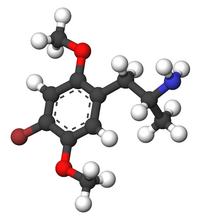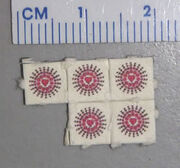Assessment |
Biopsychology |
Comparative |
Cognitive |
Developmental |
Language |
Individual differences |
Personality |
Philosophy |
Social |
Methods |
Statistics |
Clinical |
Educational |
Industrial |
Professional items |
World psychology |
Biological: Behavioural genetics · Evolutionary psychology · Neuroanatomy · Neurochemistry · Neuroendocrinology · Neuroscience · Psychoneuroimmunology · Physiological Psychology · Psychopharmacology (Index, Outline)
| DOB | |
|---|---|
| Chemical name | (4-bromo-2,5-Dimethoxy-amphetamine or 1-(4-bromo-2,5-dimethoxyphenyl)-2-aminopropane |
| Chemical formula | C11H16BrNO2 |
| Molecular mass | 274.15 g/mol |
| Melting point | 63 - 65 °C 207 - 208 °C (hydrochloride) |
| CAS numbers | 32156-26-6, 43061-15-0, 43061-16-1, 64638-07-9 |
| SMILES | N[C@H](C)CC1=C(OC)C=C(Br)C(OC)=C1 (R-isomer) |
 
| |
DOB (Brolamfetamine, Dr. Bob, Bob or Bromo-DMA) is a psychedelic hallucinogenic drug and a substituted amphetamine of the phenethylamine class of compounds, which can be used as an entheogen. DOB was first synthesized by Alexander Shulgin in 1967. In his book PIHKAL (Phenethylamines I Have Known and Loved), Shulgin lists the dosage range as 1 to 3 mg for the racemate. The enantiopure compound dosage is at least half of that. DOB is generally taken orally. According to Shulgin, the effects of DOB typically last 18 to 30 hours. Onset of the drug is also long, sometimes taking up to three hours. The substance has been described as a more lucid, more amphetamine-like version of LSD.
Chemistry[]
The full name of the chemical is 2,5-dimethoxy-4-bromoamphetamine. DOB has a stereocenter and R-(–)-DOB is the eutomer. This is an important finding as it is suggestive that it is targeting different receptors relative to most other PEAs (e.g. MDMA) where the R-isomer serves as the distomer. The toxicity of DOB is not fully known, although high doses may cause serious vasoconstriction of the extremities.

Tabs of DOB, confiscated by police in Concord, California in 2006.
DOB is the most potent compound in PIHKAL (even stronger than DOI although the two have a similar dosage, respectively). Omission of the amphetamine related α-methyl leads to 2C-B, which is less vicious and safer, albeit weaker.
(DOB) DOSAGE: 1.0 - 3.0 mg. DURATION: 18 - 30 h.
(DOI) DOSAGE: 1.5 - 3.0 mg. DURATION: 16 - 30 h.
(2C-B) DOSAGE: 12 - 24 mg. DURATION: 4 - 8 h.
(2C-I) DOSAGE: 14 - 22 mg. DURATION: 6 - 10 h.
Misrepresentation as LSD[]
Sales of DOB on blotter paper, misrepresented as LSD or mescaline, and in tablet form, misrepresented as MDMA, have been frequently reported. The misrepresentation as LSD has been described by the periodical "High Times" - this helped some users to find out what they were really taking. At least during mid- to late 1980s DOB was quite frequently sold as LSD either on blotter paper or as gelatine pyramids. [How to reference and link to summary or text]
Legality[]
Internationally, DOB is a Schedule I drug under the Convention on Psychotropic Substances[1].
References[]
- ↑ List of psychotropic substances under international control. URL accessed on 2007-03-30.
External links[]
Categorization[]
Psychedelic phenethylamines
| |
|---|---|
Aleph • 2C-B • 2C-B-FLY • 2C-C • 2C-D • 2C-E • 2C-F • 2C-G • 2C-I • 2C-N • 2C-O • 2C-O-4 • 2C-P • 2C-T • 2C-T-2 • 2C-T-4 • 2C-T-7 • 2C-T-8 • 2C-T-9 • 2C-T-13 • 2C-T-15 • 2C-T-17 • 2C-T-21 • 2C-TFM • 3C-E • 3C-P • Br-DFLY • DESOXY • DMMDA-2 • DOB • DOC • DOET • DOI • DOM • DON • Escaline • Ganesha • HOT-2 • HOT-7 • HOT-17 • Isoproscaline • Lophophine • MDA • MMDA • MMDA-2 • MMDA-3a • MMDMA • Macromerine • Mescaline • Proscaline • TMA |
.
| This page uses Creative Commons Licensed content from Wikipedia (view authors). |